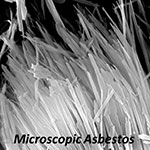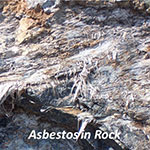Overview
Asbestos is a commercial and legal term referring to a class of minerals that naturally form long, thin, very strong fibers. Asbestos has been mined and used in many products worldwide, mostly during the 20th century. In the United States, mining asbestos has ended, but asbestos is still present in older homes and buildings, and some products still contain it. Asbestos occurs in the environment, both naturally and from the breakdown or disposal of old asbestos products.

Asbestos Hazards
Disturbing asbestos minerals or other asbestos-containing materials can release tiny asbestos fibers, too small to see, into the air. Workers and others who breathed asbestos fibers over many years have developed asbestos-related diseases, including asbestosis, pleural disease, lung cancer, and mesothelioma. Some of these diseases can be serious or even fatal.
Asbestos Properties

Asbestos occurs naturally in certain types of rock. Large amounts of asbestos in rocks can look like long fibers, but each asbestos fiber is too small to see with the naked eye. Asbestos fibers do not dissolve in water or evaporate. They resist heat and fire and cannot be broken down easily by chemicals or bacteria. Certain areas of the country have natural deposits of asbestos near the ground surface.
Asbestos in Products
Because of its sturdy properties, asbestos was mined and used in making many products, including insulation, fireproofing and acoustic materials, wallboard, plaster, cement, floor tiles, brake linings, and roofing shingles. Beginning in the 1970s, the United States banned many uses of asbestos, but asbestos is still present in old materials and is still used in products such as automobile brakes and roofing materials. Asbestos may also be present in other commercial products, such as vermiculite (especially vermiculite from Libby, Montana) and talc.
Types of Asbestos
The legal definition of asbestos applies to six fibrous minerals in two general classes:
- Serpentine class: chrysotile (also known as white asbestos)
- Amphibole class: amosite (brown asbestos), crocidolite (blue asbestos), anthophyllite, tremolite, and actinolite
Exposure to either chrysotile or amphibole asbestos increases the risk of disease. However, amphiboles remain in the lung for a longer period of time. Exposure to amphiboles may result in a higher risk of developing mesothelioma than exposure to chrysotile.
Some studies have suggested that other durable, fibrous silicate minerals (“asbestiform” minerals) such as winchite or richterite can have health effects similar to asbestos.